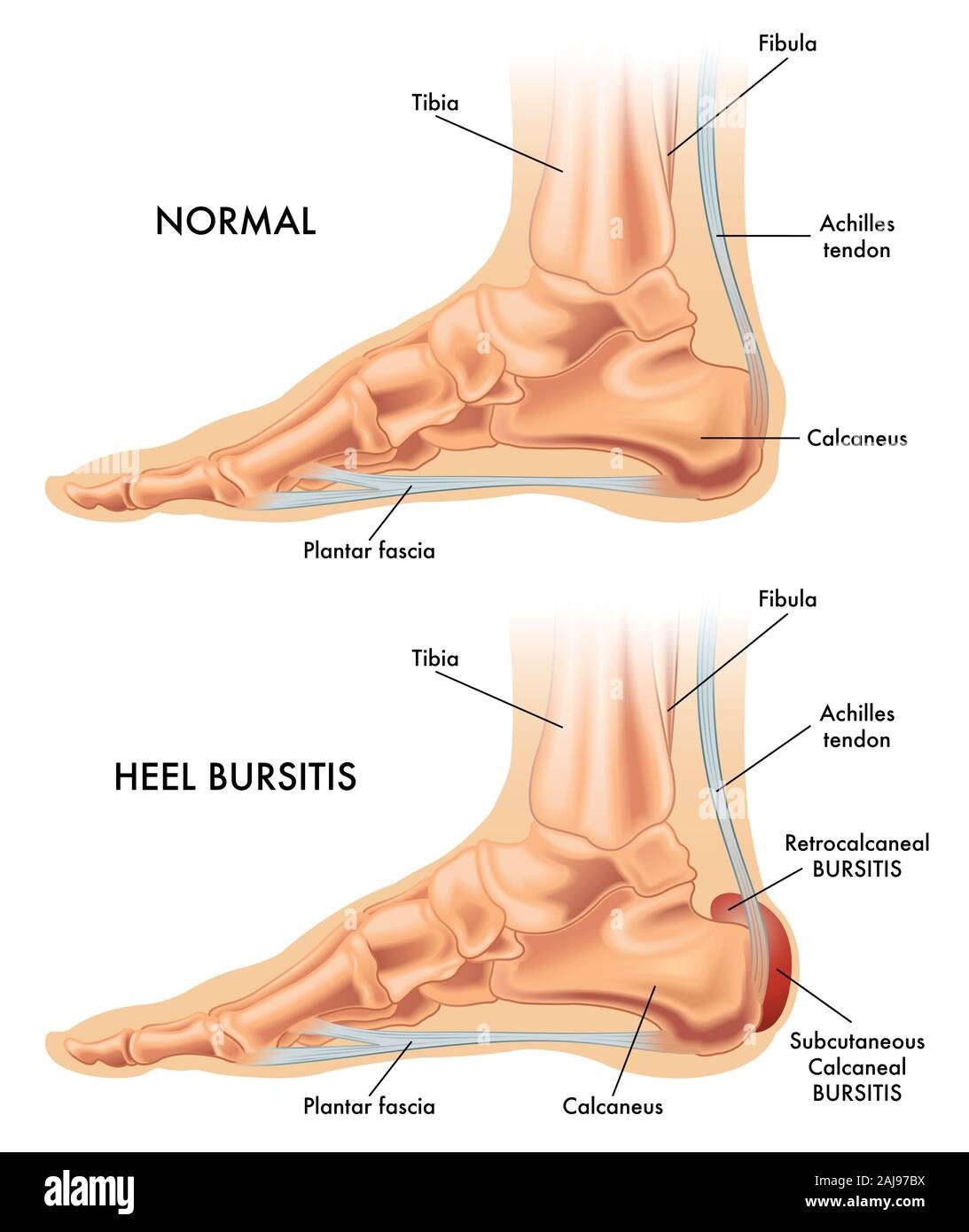October 4, 2025
Sharp, nagging pain in the heel – a familiar woe for many active individuals and even those with a more sedentary lifestyle. Often, the first culprit that comes to mind is plantar fasciitis, a common foot ailment. But what if the pain is a little different, more localized, and accompanied by a distinct swelling? You might be dealing with calcaneal bursitis, a lesser-known but equally frustrating condition. This detailed blog post will shed light on this ailment, from its causes and symptoms to effective treatment options, helping you navigate the path to recovery.
Understanding the Anatomy: What is the Calcaneus and a Bursa?
The calcaneus is simply your heel bone, the largest bone in your foot. Nestled around this bone, particularly at the back where the Achilles tendon attaches, are tiny fluid-filled sacs called bursae (plural of bursa). These bursae act as cushions, reducing friction between bones, tendons, and muscles. Think of them as the body’s natural shock absorbers.

The Culprit: When a Bursa Becomes Inflamed
Calcaneal bursitis is the inflammation of one or more of these bursae located around the heel bone. This inflammation can lead to a build-up of fluid, causing swelling, pain, and discomfort. The pain is typically felt at the back of the heel, and it can be a sharp, stabbing sensation or a dull, persistent ache.
Why Does It Happen? Common Causes of Calcaneal Bursitis
The causes are diverse, but they all boil down to irritation and pressure on the bursa.
- Repetitive Stress and Overuse: Activities that involve repeated stress on the heel, such as running, jumping, and even prolonged walking on hard surfaces, can irritate the bursa.
- Improper Footwear: Shoes that are too tight, too loose, or lack proper support can cause friction and pressure on the heel. High heels, with their unnatural angle, can also put excessive strain on the Achilles tendon and the surrounding bursae.
- Trauma or Injury: A direct blow to the heel, like landing awkwardly from a jump or a sports injury, can inflame the bursa.
- Underlying Medical Conditions: Certain systemic inflammatory conditions, such as rheumatoid arthritis, gout, and even infections, can cause bursitis as a secondary symptom.
- Biomechanical Issues: Foot structure abnormalities, like flat feet or a high arch, can alter your gait and lead to uneven pressure distribution on the heel, eventually irritating the bursa.
- Bone Spurs: A heel spur (a bony protrusion on the heel bone) can rub against the bursa, causing chronic irritation and inflammation.
Symptoms: How to Spot Calcaneal Bursitis
The symptoms of calcaneal bursitis can be similar to other heel conditions, but a careful examination can help differentiate it. Look out for:
- Localized Pain: The pain is typically felt at the back of the heel, just below the Achilles tendon insertion. It can be sharp when pressure is applied and a dull ache at rest.
- Swelling: A distinct, often noticeable swelling or a soft lump may appear at the back of the heel. It might feel warm to the touch.
- Tenderness: The area is usually very tender to the touch, and even light pressure can be painful.
- Pain with Movement: The pain often worsens with activity, especially when pushing off the foot or walking on tiptoes.
- Stiffness: You might experience a feeling of stiffness, particularly in the morning or after a period of rest.
Diagnosis: Getting the Right Answer
Your doctor will perform a physical examination, feeling for swelling, tenderness, and range of motion. They will also ask about your activity level and the nature of your pain. To rule out other conditions like a stress fracture or a bone spur, they might order imaging tests like X-rays or an MRI.
The Road to Recovery: Treatment and Prevention

The good news is that calcaneal bursitis is highly treatable, and most cases can be resolved with conservative, non-surgical methods.
- RICE Protocol: The tried-and-true method of Rest, Ice, Compression, and Elevation is the first line of defense. Rest the affected foot, apply ice packs for 15-20 minutes several times a day, use a compression bandage if needed, and elevate your foot to reduce swelling.
- Over-the-Counter Pain Relievers: Non-steroidal anti-inflammatory drugs (NSAIDs) like ibuprofen can help manage pain and reduce inflammation.
- Stretching and Strengthening: Gentle stretches for the calf muscles and the Achilles tendon can help relieve tension and prevent recurrence.
- Proper Footwear: Invest in well-fitting, supportive shoes with adequate cushioning. Orthotics or heel pads can also provide additional support and shock absorption.
- Steroid Injections: In persistent and severe cases, a doctor might recommend a corticosteroid injection directly into the bursa to reduce inflammation.
- Physical Therapy: A physical therapist can use techniques like ultrasound or electrical stimulation to promote healing and provide guidance on proper form during activities.
- Surgery: Surgery is a last resort and is rarely needed. It is considered only when conservative treatments fail to provide relief and the condition becomes chronic.
Calcaneal bursitis, while painful, is a condition that by understanding its causes, recognizing the symptoms, and committing to a proper treatment and prevention plan, you can get back on your feet and bust the painful myth of heel pain for good. However, preventing calcanea bursitis is always better than treating it. Some simple steps like Warming up Properly, Gradual Increase of Workouts, Wearing the Right Shoes and Just Listening to Your Body will save you from such a painful altercation in your life.
Disclaimer: The information presented is accurate and evidence-based, drawing from reputable sources and adhering to ethical guidelines. This information is for general knowledge and informational purposes only and does not constitute medical advice.


